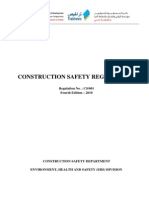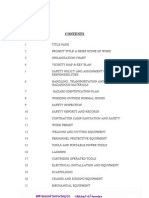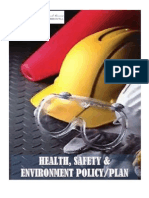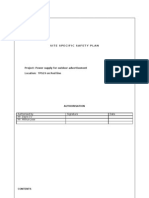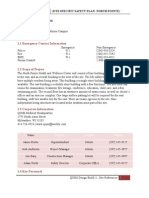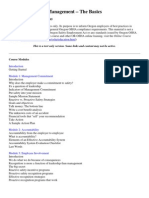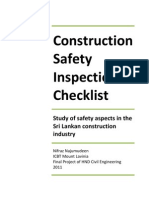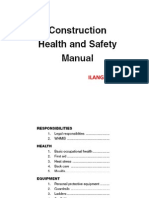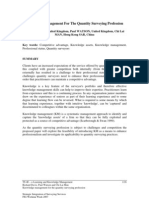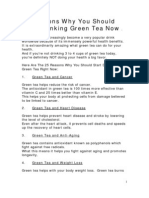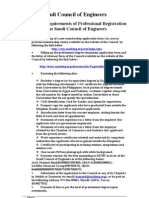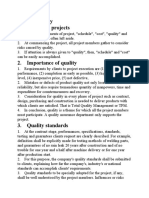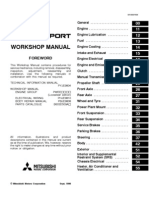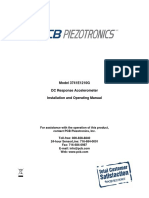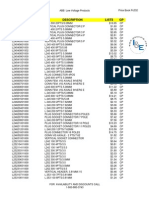Safety Plan
Safety Plan
Uploaded by
Bspeedman17564Copyright:
Available Formats
Safety Plan
Safety Plan
Uploaded by
Bspeedman17564Copyright
Available Formats
Share this document
Did you find this document useful?
Is this content inappropriate?
Copyright:
Available Formats
Safety Plan
Safety Plan
Uploaded by
Bspeedman17564Copyright:
Available Formats
Health, Safety, Environmental & Fire Prevention Safety Plan
Rev: 00
EL SEIF QUALITY CONTRACTING TRADING CO.
QATAR SILHOUTTE TOWER PROJECT PROJECT SAFETY PLAN
Name
Function/Positi on HSE Manager
Signature
Date
Content Review Authorization M. Mortada Z. Bataineh
Project Director Projects Manager
Property of El Seif Engineering Contg. Co. Ltd
Health, Safety, Environmental & Fire Prevention Safety Plan
Rev: 00
TABLE OF CONTENTS
Page 1.0 2.0 3.0 4.0 5.0 STATEMENT OF POLICY. HSE MANAGEMENT SYSTEM ... TRAINING CONTROLS . GENERAL SAFETY AND HEALTH PROCEDURES ... 5.1 5.2 5.3 5.4 5.5 5.6 5.7 5.8 5.9 5.10 5.11 5.12 5.13 5.14 5.15 5.16 6.0 7.0 8.0 9.0 10. Excavations . Personal Protective Equipment Wall and Floor Openings . Scaffolds .. Ladders Gas Welding and Cutting ... Arc Welding and Cutting Electrical .. Motor Vehicles and Heavy Equipment ... Concrete and Concrete Forms Crane and Rigging Safety .. Illumination .. Chains and Come-A-Longs Material Handling and Storage Abrasive Blasting ... Signs, Tags and Barricading ... 11 12 13 13 14 15 16 16 17 18 18 19 19 20 21 21 23 24 24 26 26 1 2 6 8 11
INDUSTRIAL HYGIENE EMERGENCY PROCEDURE . ENVIRONMENTAL PLAN ... CUTTING AND WELDING PROCEDURE FALL HAZARD CONTROL
Property of El Seif Engineering Contg. Co. Ltd
II
Health, Safety, Environmental & Fire Prevention Safety Plan
Rev: 00
0 11. 0 12. 0 13. 0
. SELF PROPELLED WORK PLATFORMS FIRE PROTECTION AND PREVENTION ... FLAMMABLE AND COMBUSTIBLE LIQUIDS ... 27 28 29
TABLE OF CONTENTS (Contd)
ATTACHMENTS
Page 1 2 3 4 5 6 7 8 9 10 11 12 13 14 Project Safety Rules & Health Regulations Supervisors Accident Investigation Report .. Weekly Safety (Tool Box) Meeting Minutes Safety Violations ... Material Safety Data Sheet (MSDS) Activity Safety Start Card .. Emergency Evacuation Plan in case of fire----------------------------------Safety Non Conformance Report. Weekly First Aid Summary Report.. Weekly Safety Performance Measurement Report.. Fire Extinguishers Log.. Disciplinary Procedure Safety Notice Form Daily Safety Inspection Report Permit to Work Form.. 32 34 36 37 38 40 41 42 43 44 45 46 47 48 49
Property of El Seif Engineering Contg. Co. Ltd
III
Health, Safety, Environmental & Fire Prevention Safety Plan
Rev: 00
1. STATEMENT OF POLICY
1.1. OBJECTIVES
The Elimination of accidents in the Project. There are three sound reasons for this objective: 1.1.1. No endeavor is worthy if it should cause human suffering through disabling injury or loss of life. 1.1.2. A good safety record reflects the quality of management, supervision and the work force. It also serves to promote business and thereby contributes to the continuing growth and success of the company. 1.1.3. Poor accident experience increases costs and results in a loss of profits.
1.2. GOALS
The safety goals of this project are to achieve zero fatalities, zero permanent disabilities, zero lost- time accidents, and a safety performance level below 50% of OSHA heavy construction average injury rates.
1.3. STATEMENT OF POLICY
1.3.1. EL SEIF is guided by an established accident-prevention policy. This policy is based on a sincere desire to eliminate personal injuries, occupational illnesses and damage to equipment and property, as well as to protect the general public whenever and wherever the public comes in contact with, or is affected by the facilities construction activity. 1.3.2. EL SEIF will maintain a safety and accident prevention program which meets the requirements of the Host Country, local codes, and all other authorities having jurisdiction over the Work 1.3.3. Management and supervision are charged with the responsibility of preventing the occurrence of incidents or conditions that could lead to occupational injuries or illness. While the ultimate success of the Safety, Health and Fire Prevention Program depends upon the full cooperation of each individual employee, it is management's responsibility to ENFORCE Safety Procedures and good practices. 1.3.4. Safety shall be considered an integral part of quality control, cost reduction and job efficiency. 1.3.5. Every supervisor shall be responsible for the safety performance demonstrated by the employees under his supervision. Employees are responsible to abide by procedures, use tools and equipment safely, follow the rules and use personal protective equipment provided.
Property of El Seif Engineering Contg. Co. Ltd
Health, Safety, Environmental & Fire Prevention Safety Plan
Rev: 00
1.3.6. Even though we believe our Program to be most effective, we recognize that such program must continuously evolve and be reviewed and modified to meet changing project conditions. Our policy is to accomplish work in the safest possible manner consistent with good practices. Management and supervision at every level is charged with the task of translating this policy into positive actions.
1.4. PURPOSE AND SCOPE
1.4.1. EL SEIF requires that a consistent Construction Safety, Health and Fire Prevention Program be employed during all activities of its employees, agents, and subcontractors. This Construction Safety, Health and Fire Prevention Manual represents El Seif expectation for efforts conducted by itself and its subcontractors at all times. 1.4.2. In performance of contracting activity, commitment shall be established for accident prevention and fire prevention. Safety shall be of high priority to eliminate personal injuries, occupational illnesses and damage to equipment or property, as well as protecting the general public whenever they may be affected by the work. 1.4.3. Management and supervision shall recognize the responsibility for compliance to all established codes, regulations, standards and procedures. 1.4.4. In performance of the work, EL SEIF and its subcontractors shall meet the requirements of the Host Country, local codes and all other authorities having jurisdiction over the Work. 1.4.5. A training program, starting with the basic Safety Induction program, shall be effectively established for each employee soliciting their full cooperation and compliance.
1.4.6. EL SEIF and its subcontractors shall plan storage, and disposal of
any chemicals, refuse, waste, or other materials generated or used in the performance of the work in accordance with this Safety, Health, and Fire Prevention Manual.
2.
HSE MANAGEMENT SYSTEM
2.1. PURPOSE AND SCOPE
2.1.1. To establish, implement and execute a practical, sound and effective Construction Safety, Health, and Fire Prevention Program to accomplish work in a safe manner consistent with good work practices. 2.1.2. The Project Safety, Health and Fire Prevention Program has been designed to assist EL SEIF Management and subcontractors and their supervision to recognize, evaluate and control hazardous activities or conditions within their scope of work. 2.1.3. The purpose of this Program is directed to the following:
Property of El Seif Engineering Contg. Co. Ltd
Health, Safety, Environmental & Fire Prevention Safety Plan
Rev: 00
a) Provide safe and healthy working conditions for all persons working on the Project. b) Maintain the Project Fire Prevention Program to eliminate fire hazards and provide adequate means to fight any fire that might occur and provide for proper notification of the Engineer, Owner and local authorities. c) Protection of the general public. d) Avoidance/Reduction of accident and related costs. e) To act as a guide for interpretation of current Labor Laws, provincial and local laws, statutes, ordinances, rules, regulations, requirements and guidelines of government authorities and agencies bearing on the performance of the work and agencies as outlined in this procedure. f) EL SEIF management & supervisory personnel shall ensure employee and public safety for work directly under their control. g) EL SEIF management and supervisory personnel shall not assume or relieve subcontractors from their direct responsibility for employee and public safety.
2.2. OBJECTIVE
Identify the Program and how it shall be administered, responsibilities and ensure adequate Control.
2.3. PROGRAM EFFECTIVENESS
2.3.1. The effectiveness of the Safety Program depends upon the active participation and sincere cooperation of all employees, and the coordination of their efforts in carrying out the following basic responsibilities: a) Proper planning of all work to minimize personal injury, property damage, and the loss of productive efforts. b) Establish and maintain a system for early detection (Risk Assessment & control) and correction of unsafe practices and conditions. c) Provide adequate protection of adjacent public and private properties to ensure the safety of the public at all times. d) Establish and conduct a Safety Program designed to gain, stimulate and maintain the interest and active participation of all employees through: (i) (ii) (iii) (iv) (v) Safety meetings and communications (see Attachment 3). Investigations of accidents and potential safety incidents to determine cause and the taking of necessary corrective actions (see Attachment 2). Use of proper work procedures, personal protective equipment and mechanical guards. Safety instruction to individual employees and group Safety Training Programs. Maintenance of records of accidents and losses and development of accident/loss experience summaries.
2.4. PROCEDURES
Property of El Seif Engineering Contg. Co. Ltd
Health, Safety, Environmental & Fire Prevention Safety Plan
Rev: 00
2.4.1. Administration a) Safety Induction to all employees, subcontractor and visitors shall be carried out prior to their deployment on site. The induction shall cover all the basic Safety Requirements (PPE) awareness for all to ensure observance and/or compliance of the same in and around the project premises. EL SEIF is responsible for monitoring the Project Safety, Health and Fire Prevention Program, which includes auditing the safety performance and monitoring compliance of all subcontractors, with applicable Labor Laws, provincial, local and EL SEIF Safety, Health and Fire Prevention requirements. (see attachments 9 & 10) Daily inspections shall be conducted by the EL SEIF Safety Supervisor and field supervision management in conjunction with site supervision. Inspections shall include subcontracted work in conjunction with subcontractors site supervision. (see Attachment 13). Whenever unsafe conditions and fire hazards are noted and immediate corrective action cannot be obtained, the Safety Supervisor or subcontractor shall be notified in writing of the unsafe condition and is required to correct the situation and notify the EL SEIF Safety Manager of action taken within specified time. (see Attachment 4 & 8) Should there be a conflict between any applicable safety laws, rules, etc., the most stringent shall apply. The EL SEIF Safety Manager shall be the final authority in regard to any question or conflict that may occur regarding the interpretation of, or the compliance with, any safety laws, rules, etc.
b)
c)
d)
e)
2.4.2. Subcontractors Each major subcontractor shall designate, in writing, a qualified person, knowledgeable in safety, health and fire prevention whose responsibilities shall be solely responsible for performing safety, health and fire prevention services under the direction of the subcontractor's Project Manager. Any deviation from the above shall be submitted for approval. a) Upon award of a subcontract, and prior to commencing work on site, the subcontractors shall submit the following for review and approval: (i) (ii) Company's safety policy statement based on compliance with the Projects Safety, Health and Fire Prevention Program. Safety Program shall identify areas of compliance under their scope of work, interfacing with the Project Safety, Health and Fire Prevention Program.
b)
Submit a history of experience and qualifications of the person who shall manage their safety functions on site. Once approved, the Safety Representative shall not be changed except upon approval of EL SEIF. Such approval does not
Property of El Seif Engineering Contg. Co. Ltd
Health, Safety, Environmental & Fire Prevention Safety Plan
Rev: 00
relieve the subcontractor of any of his responsibilities or obligations. c) The subcontractor shall furnish full information concerning safety of his operations on the Project as may be required by EL SEIF Team. All personnel working on the project shall attend Weekly Tool Box Safety Meetings provided by EL SEIF or subcontractor. Each subcontractor shall indoctrinate his employees as to the safety, health and fire prevention requirements and enforce adherence to safe working practices and procedures. Each subcontractor is responsible for planning and execution of all work in harmony with the stated objectives of the Projects Safety Plan. Each subcontractor shall assist in accident investigations, and preparation and submission of required reports. Each subcontractor shall attend weekly safety meetings held by EL SEIF. (This meeting shall be in conjunction with weekly construction meeting.) Each subcontractor shall provide and enforce the use of personal protective equipment required by Qatar Labor Law, Provincial, local and Project Safety regulations. Each subcontractor shall fully comply with the Hazard Communication Program as outlined in this Project Safety Manual. Each subcontractor shall complete supervisory investigation reports on accidents as required. Each subcontractor shall conduct minimum daily safety inspections of the work areas and take necessary and immediate corrective actions to eliminate all unsafe acts and/or conditions. Each subcontractor shall hold weekly management safety inspections with EL SEIF construction supervision and safety. Each subcontractor shall maintain a clean work site. Subcontractors, so notified, shall make all efforts to correct the unsafe conditions or acts. Satisfactory corrective action shall be taken within a specified time. If the subcontractor refuses to correct unsafe or unhealthy conditions or acts, or eliminate fire hazards, EL SEIF shall take one or more of the following steps: (I) (ii) (iii) Cease the operation or a portion thereof; And STOP payment for the work being performed; and Or correct the situation and back charge the subcontractor for expenses incurred.
d) e)
f)
g) h)
i)
j)
k) l)
m) n) o)
2.4.3. Employees
Property of El Seif Engineering Contg. Co. Ltd
Health, Safety, Environmental & Fire Prevention Safety Plan
Rev: 00
All employees shall comply with all safety rules and regulations applicable to their work and to the general safety of the other workers on the project. It is the responsibility of each employee to support EL SEIF in providing a safe place to work, to protect themselves and co-workers against injuries and to correctly report all safety hazards at once to project supervision. 2.4.4. Injury Reporting Employees shall immediately report all injuries to their employer for first aid and/or medical treatment. Should EL SEIF elect to provide onsite medical, injury treatment shall be coordinated through the EL SEIF Safety Department. 2.4.5. Accident Reports All accidents resulting in medical treatment to employees or property damage shall be verbally reported to EL SEIF Safety immediately, with a formal written accident report submitted within (24) hours or end of working day. Filling out of accident reports carefully and completely shall help in the analysis of the accident and be utilized in the prevention of similar accidents in the future (Attachment 2). 2.4.6. Guidelines for Corrective Action and Enforcement (see attachment 12) a) b) c) Subcontractors shall be required, in accordance with project safety regulations to comply with all safety directives. Repeated violations or lack of cooperation with regard to these procedures may be cause for termination. Should an imminent danger condition be discovered, all work in the area of danger shall be stopped until corrective action is taken. It is imperative that employees at every level comply with the provisions and directives of the Safety Program at all times while working. Repeated violations by employees will indicate noncompliance, and can be reason for removal from the Project. Flagrant violations of Project Safety, Health and Fire Prevention regulations can lead to immediate termination.
d)
e) f)
3.
TRAINING
3.1. PURPOSE AND SCOPE
To establish and implement training procedures.
3.2. OBJECTIVE
Property of El Seif Engineering Contg. Co. Ltd
Health, Safety, Environmental & Fire Prevention Safety Plan
Rev: 00
To ensure that all employees, are properly trained in hazard recognition.
3.3. RECORDS AND MINUTES
All safety-related meetings, including "Tool-Box" shall be documented and the record of the meeting transmitted to EL SEIF Safety within 24 hours of the meeting (Attachment 3).
3.4. TRAINING
3.4.1. Regular and continuing training of employees is required. In addition employees shall receive special training prior to being assigned an unfamiliar task. Listed below, but not limited to, are areas where training is required: a) b) The recognition and avoidance of unsafe conditions and means for correcting the unsafe conditions. The employee shall also be made aware of any potential hazards, personal hygiene and personal protective measures required. Employees handling or using flammable gases, liquids or toxic materials shall be instructed in the safe handling and use of these materials. Employees required to enter into confined or enclosed spaces shall be instructed as to the nature of the hazards involved, the necessary precautions to be taken, and the use of protective and emergency equipment required. Employees are to be trained in the recognition, selection, and use of proper fire extinguishers to be used in the event of fire. Employees, used as flagmen, shall be trained as to the method and manner of proper flagging. Also, flagmen shall be trained in the selection of proper clothing and equipment. Employees who are exposed to harmful dusts, mists, vapors, or gases shall be trained in the selection, care, use and maintenance of respirators per the approved written respiratory protection program before working in any such conditions. Employees used to direct cranes, backhoes, etc. shall be trained in the proper method of giving signals. All employees using aerial lifts or man lifts shall be trained. Documentation shall be maintained and prior to training, the training program shall be reviewed and accepted by the EL SEIF Safety Department.
c)
d)
e) f)
g)
h) i)
3.5. BULLETIN BOARD
Property of El Seif Engineering Contg. Co. Ltd
Health, Safety, Environmental & Fire Prevention Safety Plan
Rev: 00
3.5.1. A project safety bulletin board shall be located at each major work site. The bulletin boards shall be utilized for the posting of safety information and posters. 3.5.2. In addition, all subcontractors shall have a safety bulletin board located at their office area for posting of safety information.
3.6. MEETINGS
3.6.1. Safety meetings shall be utilized on the project for achievement of a successful Accident Prevention Program. a) Construction Meetings Safety shall have a prominent place on the agenda and records of the meeting shall reflect specific items discussed. b) Tool-Box Meetings Weekly safety training meetings shall be conducted by supervisor or foremen. Attendance is mandatory for all subcontractor employees at the work site. The meeting provides an opportunity to point out any hazardous, unhealthy conditions, or unsafe work practices that have been noticed. A record of these meetings shall be maintained (Attachment 3). c) Special Meetings EL SEIF Safety Department may call such special meetings as necessary. Attendees shall be notified and the meeting topic(s) noted in a memo. Attendance shall be mandatory. d) Safety Representative Meetings EL SEIF Safety Department shall, as determined by its Safety Officer, hold mandatory safety meetings for all subcontractors Safety Representatives prior to toolbox safety meetings. the
4.
CONTROLS
4.1. PURPOSE AND SCOPE
To establish and maintain a consistent Project Safety, Health, and Fire Prevention Program through continuous safety audits by EL SEIF and subcontractor representatives.
4.2. PROCEDURE
In order to provide a continuous and consistent safety control, the following areas, not inclusive, shall be reviewed and inspected regularly: 4.2.1. Personal Protective Equipment EL SEIF and subcontractors need to ensure that they have adequate quantities of protective equipment available, such as
Property of El Seif Engineering Contg. Co. Ltd
Health, Safety, Environmental & Fire Prevention Safety Plan
Rev: 00
hearing protection, safety glasses, hard hats, safety harnesses, Safety Shoes etc. 4.2.2. General Order and Housekeeping Check storage of new and waste materials. Keep walkway and traffic areas clear. Management and supervision shall be fully responsible for ensuring that its employees, subcontractors, and other persons performing the work at the site keep work areas and adjoining premises free at all times from accumulations of all waste materials, rubbish, debris, broken concrete, and other scrap resulting from the performance of their work. All non-hazardous waste material, rubbish, and debris shall be removed from the building, trailers, lay down areas and placed in closed top containers. Such containers shall be removed from the site when full and shall be properly disposed of at an off-site location. 4.2.3. Work areas shall be kept clean and free of trash, rubbish and debris at all times. 4.2.4. Inspect ladders, stairs, handrails, fences, and barricades daily. 4.2.5. Inspect scaffolding and platforms noting strength of supports. Assure that scaffolds over 2 meters high are protected with standard guardrails and toe boards. All scaffold boards shall be checked for defects and equipped with cleats to prevent them from sliding. 4.2.6. Tools Check for burrs, dull points, heads are properly fitted on handles, and if power driven check electrical cords, are in good working order. 4.2.7. Hoists, Hoisting Equipment, Cranes, and Derricks Note condition of platforms of hoists, cable supports, signal arrangements, guarding hoist ways, support of sheaves, strength of boom, condition of hoisting cables and guys. Employees SHALL NOT ride rigging or rigged loads. 4.2.8. Floors Note strength and security, guards and hoist ways, and stairway openings. 4.2.9. Electrical Equipment Note condition of insulation on conductors, and guarding of live circuits. Assure the use of ground fault circuit interrupters (GFCI) as required and see that they are operable. 4.2.10. Engines and Compressors Note guarding of moving parts; inspect air line hoses, hose connectors and "dead-man" controls. 4.2.11. Machines
Property of El Seif Engineering Contg. Co. Ltd
Health, Safety, Environmental & Fire Prevention Safety Plan
Rev: 00
Note guarding of gears, belts, pulleys, shafting, and method of oiling and greasing. 4.2.12. Welding and Burning Operations Assure that welders and helpers wear proper personal protective equipment and that welding machines are properly maintained. Check storage and transportation of acetylene and oxygen tanks. Provide welding shield when other personnel are working in the area or shield them from the area. Welders and helpers should know that oxygen may not be used in place of compressed air, as serious explosions and burns may result. 4.2.13. Flammable and Combustible Materials Inspect work areas for proper placement or storage of flammable and combustible materials. Burning, welding, or other fire generating work shall not be performed unless storage of materials is properly protected. 4.2.14. Fire Protection Devices (see Attachment 11) Portable fire extinguishers shall be inspected and the inspection tag initialed monthly. The subcontractor shall be responsible for his extinguishers and the contractor for the contractors extinguishers. 4.2.15. Noise Noise control at the source is required if feasibly possible, but properly fitted ear plugs and/or ear muffs shall be worn when an employee is exposed to noise levels greater than 85 dab time weighted average (TWA). 4.2.16. Automotive Vehicle Equipment Check condition and maintenance of trucks, tractors, and passenger vehicles. Assure that equipment is properly operated about the work area and assure that each vehicle on the job site has a current, valid vehicle pass. 4.2.17. General Conditions
Assure that personal protective equipment and clothing is used as required. Check for proper lighting at all points. See that nails are removed or bent over in old forms and lumber, and other physical hazards are controlled.
4.3. PLANNING
Due to the complexity of the project and the activities of other subcontractors, construction operations shall be extensively planned to include safe construct ability procedures.
4.4. AUDITS
Property of El Seif Engineering Contg. Co. Ltd
10
Health, Safety, Environmental & Fire Prevention Safety Plan
Rev: 00
Formal safety audits shall be periodically conducted by a composite audit team of EL SEIF and subcontractor management personnel. A weekly performance measurement report shall be generated from these audits (see attachment 10)
4.5. NOTIFICATION OF HAZARDS
4.5.1. Each subcontractor shall notify EL SEIF in writing of the existence of any hazardous conditions, property, or equipment at the work. However, the subcontractor shall take all necessary precautions against injury to any employees until corrected by the responsible party. 4.5.2. If the premises are not cleaned as required, then EL SEIF shall notify the subcontractor that the premises are not being maintained in the condition required. Should the subcontractor fail to initiate substantial progress toward cleanup of the premises within twenty-four (24) hours following receipt of said notice, EL SEIF may elect to provide the necessary labor, materials, and equipment to achieve the same and deduct the full cost thereof from any moneys due the subcontractor.
5.
GENERAL SAFETY AND HEALTH PROCEDURES
5.1. EXCAVATIONS
5.1.1. EL SEIF and all subcontractors shall comply with the standards of the Qatari Labor Laws/Local Laws and this Project Safety, Health and Fire Prevention Manual. 5.1.2. A trench is referred to as a narrow excavation in which the depth is greater than the width; although the width is not greater than 5 meters. An excavation is any man-made cavity or depression in the earth's surface. This can include excavations for anything from cellars to highways. 5.1.3. The Project requires that all excavations over 1.5 meters deep be sloped, shored, benched, braced, or otherwise supported. When soil conditions are unstable, excavations shallower than 1.5 meters also shall be sloped, supported, or shored. 5.1.4. One method of ensuring the safety of workers in a trench or excavation is to slope the sides to a safe angle. The angle varies with different kinds of soil and shall be determined on each individual project. When an excavation has water conditions, silty material, or loose boulders, or when it is being dug in areas where erosion or slide planes are apparent, the safe angle shall be flattened. 5.1.5. A second method of support is shoring-sheeting, tightly placed timber shores, bracing, trench jacks, piles, or other materials installed in manner strong enough to resist the pressures surrounding the excavation. 5.1.6. A trench box, a prefabricated, movable trench shield composed of steel plates welded to a heavy steel frame may also be used.
Property of El Seif Engineering Contg. Co. Ltd
11
Health, Safety, Environmental & Fire Prevention Safety Plan
Rev: 00
5.1.7. All excavations of a depth of one (1) meter or greater shall be reviewed by EL SEIF Safety and excavations greater than 1.5 meters, shall require a task safety analysis prior to the work. 5.1.8. Underground lines, equipment and electrical cables shall be identified, located and marked prior to beginning excavation work. 5.1.9. Physical barriers shall be placed around or over trenches and excavations. Barriers shall be temporarily removed only when necessary to provide access to personnel or equipment. Once the equipment or personnel have entered or exited, the barrier shall be immediately replaced. Flashing light barricades shall be provided at night when work is performed or traffic is anticipated near by at night, or as designated. 5.1.10. A stairway, ladder, ramp or other safe means of egress shall be located in trench excavations so as to require no more than 8 meters of lateral travel for employees. Any ladder shall extend a minimum of 1.0 meter above the ground level. 5.1.11. When mobile equipment is operated adjacent to an excavation, and the operator does not have clear and direct view of the excavation edge, a warning system shall be used such as a spotter person(s) to warn the operator, barricades, or mechanical signals, or stop log. 5.1.12. Employees shall not be permitted to work in excavations if there is an accumulation of water or in excavations in which water is accumulating, unless precautions have been taken to protect the employee.
5.2. PERSONAL PROTECTIVE EQUIPMENT
All employees shall use the protective equipment as prescribed by the Qatari Labor Law and rules and regulations as stated in the EL SEIF Safety, Health and Fire Prevention Manual to control or eliminate any hazard or other exposure to illness or injury. Any employee who willfully refuses to use the prescribed protective equipment designed to protect him or willfully damages such equipment shall be subject to disciplinary action, which may include immediate removal from the job site. 5.2.1. Hearing Protection Appropriate hearing protection shall be worn in work areas where noise levels exceed 85 dab time weighted average (TWA). 5.2.2. Eye and Face Protection Eye protection includes approved safety glasses with side shields of monologues meeting the safety Standards. Eye protection will be required as appropriate for the task being performed. Dark protective eyeglasses shall not be worn inside buildings. 5.2.3. Hard Hats All construction employees shall wear approved non-metallic hard hats. All employees and visitors shall wear approved hard hats
Property of El Seif Engineering Contg. Co. Ltd
12
Health, Safety, Environmental & Fire Prevention Safety Plan
Rev: 00
when entering areas of construction or overhead hazards. Hard hats shall be void of any type of defects and should not be altered. 5.2.4. Respirators Approved respirator shall be used when excessive dusts, mists, gases or other atmospheric impurities are determined to be harmful to health. 5.2.5. Safety Harness and Lifelines Safety harnesses and secured safety lanyards shall be used by all employees working from unguarded surfaces when falls to a different level present a hazard. Each employee shall also wear a safety harness with a safety lanyard secured to a separate life line while working from swing scaffolds, bosss chairs, or other suspended work platforms when a falling hazard is present (See Fall Hazard Control, Section 11.0). 5.2.6. Foot Protection All persons working in the construction site shall wear sturdy foot protection. It is recommended that low-quarter footwear not be worn, due to inadequate ankle support. At no times shall soft sole, canvas shoes or opened toed footwear (sandals) be allowed on the construction site. Footwear shall be worn as shoes, not as sandals. 5.2.7. Skin Protection Protect your skin from sun, welding, hot pipe burns, and other hazards that exist in the construction areas by wearing proper extremities clothing protection. THIS INCLUDES LONG PANTS FOR LEG COVERING AND SHIRTS THAT HAVE MINIMUM FOUR-INCH SLEEVES. NO SHORTS OR TANK TOPS (shirts without sleeves and fully covering the torso) ARE ALLOWED ON SITE. Clothing shall be kept in good repair and in clean condition.
5.3. WALL AND FLOOR OPENINGS
5.3.1. Floor, wall, deck, manhole and other like openings shall be immediately guarded when made or opened by standard guardrails and toe boards, or covers that are secured against accidental displacement. Floor holes covers shall to be stenciled "HOLE COVER DO NOT REMOVE" and of sufficient strength to safely bear all intended loads. 5.3.2. Manhole and temporary floor openings shall be immediately guarded by standard covers. When the cover is not in place, the opening shall be immediately protected by a standard guardrail. 5.3.3. Wall openings, from which there is a drop of 1.25 meters and the bottom of the opening is less than l meter above the working surface, shall be guarded. 5.3.4. Runways shall be guarded by a standard railing, or the equivalent on all open sides 1.25 meters or more above floor or ground level.
Property of El Seif Engineering Contg. Co. Ltd
13
Health, Safety, Environmental & Fire Prevention Safety Plan
Rev: 00
Whenever tools, machine parts, or materials are likely to be used on the runway, a toe board shall also be provided on each exposed side. Trench crossings for equipment use shall be of adequate strength to support equipment in area. 5.3.5. Regardless of height, open-side floors, walkways, platforms, or runways above or adjacent to dangerous equipment and similar hazards, or designated by EL SEIF shall be guarded with a standard railing and toe board.
5.4. SCAFFOLDS
5.4.1. Lean-to scaffolds and makeshift platforms are prohibited. 5.4.2. Scaffolds shall not be used for the storage of material except material being currently used that work shift. 5.4.3. All scaffolds shall be adequately designed to carry, without failure, four (4) times the maximum intended load. At no time shall any scaffold be overloaded. 5.4.4. All scaffolds shall be maintained in safe condition and scaffolds damaged or weakened, from any cause, shall be immediately repaired or dismantled. 5.4.5. Scaffolding or staging more than two (2) meters above the ground or floor, suspended from an overhead support, or erected with stationary supports, shall have standard guardrails and toe boards properly attached. 5.4.6. Scaffolds shall be provided with an access ladder or equivalent safe access. Employees shall not climb or work from scaffold handrails, mid-rails or brace members. 5.4.7. When freestanding manually propelled mobile scaffolds are used, the height shall not exceed four times the minimum base dimension. They shall be equipped with wheel brakes on a minimum of 2 wheels which shall be engaged at all times employees are on the scaffold. Such scaffolds shall not be rolled or moved with employees on them. 5.4.8. All work platforms on scaffolds shall be totally decked without unguarded openings, and all decking shall be secured against displacement. 5.4.9. Whenever a scaffold cannot be erected with handrails, personnel working on said scaffold shall be provided with safety harness and safety lanyard. 5.4.10. Guardrails shall be 5 cm by 10 cm or the equivalent, approximately one (1.05) meter high with midriff. Supports shall be at intervals not to exceed 2.5 meters. Toe boards shall be a minimum of 10 cm in height. Planking shall be cleared or otherwise secured to prevent displacement. Scaffolds shall be brace and tied off both horizontally and vertically at intervals specified in the pertinent regulations or as specified by EL SEIF.
Property of El Seif Engineering Contg. Co. Ltd
14
Health, Safety, Environmental & Fire Prevention Safety Plan
Rev: 00
5.4.11. Subcontractors shall designate in writing its competent person for the erection, daily inspection, repair, maintenance and dismantling of scaffolds. Scaffolds shall be tagged denoting their status, whether complete or incomplete. Employees shall not be permitted onto incomplete scaffold except those required to complete the scaffold.
5.5. LADDERS
5.5.1. Employees shall be instructed and required to ascend/descend ladders in the proper manner; that is, facing the ladders and holding the side rails with both hands. Material shall be raised or lowered with a line hoisting equipment and not carried in one hand while ascending or descending; when working from ladders, three point contact shall be maintained at all times. 5.5.2. Wood ladders shall not be painted as this may cover-up defects and deterioration. 5.5.3. The areas at the base and top, side rails and cleats or rungs on ladders shall be kept clean and free of lines, hoses, cables, wires, oil, grease, and debris. 5.5.4. If a ladder is to provide the only means of access or exit from a working area for 25 or more employees, or simultaneous two-way traffic is expected, a double cleat ladder shall be installed. 5.5.5. Portable ladders shall be placed so the horizontal distance at the bottom of the ladder is not less than one quarter (1/4) of the vertical distance to the top support. In case of necessity that, the ladder is placed more horizontal, it shall be braced to prevent sagging. All ladders shall be secured at the top, to prevent displacement. 5.5.6. Portable ladders shall be placed so that the side rails have a secure footing. The top rest shall be rigid and have ample strength to support the applied load. 5.5.7. Ladders with broken or missing rungs or steps broken or split side rails or other faulty and defective construction shall not be used and shall be immediately destroyed or immediately removed from the project site. 5.5.8. Single portable ladders over ten (10) meters in length shall not be used. If greater heights are to be reached, separate ladders shall be used with intermediate landing platforms provided. 5.5.9. Portable ladders, used on smooth floor or other smooth surfaces, shall be equipped with non-slipping bases, or otherwise secured to prevent displacement. 5.5.10. Ladders shall be sufficient length to project not less than one (1) meter above the top landing. When this is not practical, grab rails, which provide a secure grip for an employee moving to or from the point of access, shall be installed. 5.5.11. Aluminum and/or metallic ladders are prohibited around energized electrical panels and lines.
Property of El Seif Engineering Contg. Co. Ltd
15
Health, Safety, Environmental & Fire Prevention Safety Plan
Rev: 00
5.5.12. Persons shall not work off the top of a stepladder. 5.5.13. Subcontractors shall designate in writing a competent person to provide training and inspection of ladders and their use.
5.6. GAS WELDING AND CUTTING
5.6.1. All cutting and welding operations are required to have within easy reach a proper fire extinguisher of a size and type to extinguish any fire that may ignite on materials being cut or welded or materials immediately adjacent to cutting and welding operation. 5.6.2. All oxygen/acetylene cylinders shall be kept in an upright position and secured by chain or other suitable means to prevent accidental displacement. A cylinder truck, with chain, is a preferred method of usage for the above. 5.6.3. Full and empty cylinders of oxygen shall not be stored close to cylinder of acetylene or other fuel gas. They shall be separated by a minimum of 7 meters, or by a noncombustible barrier accepted by EL SEIF. 5.6.4. Oxygen cylinders, cylinder valves, couplings, regulators, hoses, and apparatus shall be kept free from and away from oil and grease. Oil or grease in the presence of oxygen under pressure will ignite violently. 5.6.5. Cylinders in storage shall be kept away from sources of heat and shall be protected against the direct rays of the sun. 5.6.6. Empty cylinders shall have their valves closed. Valve protection caps shall always be in place except where cylinders are in use or connected for immediate use.
5.7. ARC WELDING AND CUTTING
5.7.1. All arc welding and cutting operation are required to have within easy reach a proper fire extinguisher of a size and type to extinguish any fire that may ignite on materials being cut or welded or materials immediately adjacent to cutting and welding operations. 5.7.2. Welding current return circuits or grounds shall be attached to the welding as close as possible and shall carry their current without hot or sparking contacts and without passage of current through equipment or structures which might be damaged or made unsafe by the welding current or its voltage. Specifically, welding current shall not be allowed to pass through any of the following materials: a) b) c) d) Compressed gas cylinders. Flammable or combustible material storage containers. Conduits carrying electrical conductors. Chains, wire ropes, cranes, hooks, hoisting or rigging equipment, metal hand railings, ladders, machines, shafts, bearings, or weighing scales.
Property of El Seif Engineering Contg. Co. Ltd
16
Health, Safety, Environmental & Fire Prevention Safety Plan
Rev: 00
5.7.3. All arc welding and cutting operations shall be shielded by noncombustible or flameproof screens. Warning signs shall be posted if shielding is not practical as determined by and accepted by EL SEIF. 5.7.4. The ground for the welding circuit shall be mechanically strong and electrically adequate for the safe passage of workers. 5.7.5. Where it is necessary to couple, or uncouple, several lengths of cable for use as a welding circuit, insulated cable connectors shall be used on both the ground line and the electrode holder line. Coupler joints shall be fully insulated. Welding machine supply lines shall be maintained in the shortest length possible. 5.7.6. Cables with worn or damaged insulation shall not be used and shall be immediately repaired or removed from the project site. 5.7.7. An insulated electrode holder (stinger) of adequate rated current capacity shall be used at all times. 5.7.8. Welding cables and gas hoses shall not be placed on stairs, walkways, ground or floor where they are exposed to damage by foot traffic or create interference to walking or work area access
5.8. ELECTRICAL
5.8.1. All temporary and permanent electrical work, installation, and capacities shall conform to applicable Qatari codes. 5.8.2. Only qualified electricians, familiar with code requirements, shall be allowed to perform electrical work. Only qualified electricians shall repair electrical equipment including power tools. 5.8.3. No employee shall be permitted to work close to unprotected electrical power circuit so that he may contact the same in the course of his other work, unless the employee is protected against electrical shock by de-energizing the circuit and grounding it or guarding by effective insulation or other means accepted by EL SEIF. 5.8.4. Electrical equipment or machinery shall be de-energized and rendered inoperative by the electrician locking out supply switches prior to performing work. The only exception is when power shall be applied for the purpose of adjustments or electrical troubleshooting. 5.8.5. Extension cords used with portable electrical tools and appliances shall be of the three-wire type. Cords with the ground probe removed or rendered ineffective shall be removed from service. 5.8.6. Electrical cords and trailing cables, which could create a hazard to employees or other persons in the area, shall be covered, elevated or otherwise protected from damage. Cords and cables shall not be placed on the ground or walking surface in work areas unless first accepted by EL SEIF. 5.8.7. The use of extension cords is limited as possible. Both male and female plugs are of the dead front type.
Property of El Seif Engineering Contg. Co. Ltd
17
Health, Safety, Environmental & Fire Prevention Safety Plan
Rev: 00
5.8.8. Electrical cords and temporary wiring, when elevated, shall be secured with non-metallic material. Tie-wire or other conductive material shall not be used. They shall be elevated a minimum of 2.0 meters above the walking or work surface.
5.9. MOTOR VEHICLES AND HEAVY EQUIPMENT
5.9.1. All construction vehicles and equipment before being brought onsite shall be inspected, tested and certified to be in a safe operating condition, in writing by subcontractors. Personnel operating motor vehicles shall give pedestrians right of way and obey all signs and watch for blind intersections. 5.9.2. Only authorized drivers shall be permitted to operate vehicles assigned for use on the project. Accidents shall be reported immediately to the EL SEIF Safety Department. 5.9.3. All construction equipment and vehicles shall have a backup alarm, audible above the surrounding noise level 50 meters to the rear. 5.9.4. All track type construction equipment shall have a travel alarm, audible above surrounding noise level. 5.9.5. All haulage vehicles, whose payload is loaded by means of cranes, power shovels, loaders, or similar equipment shall have a cab shield and/or canopy adequate to protect the operator from shifting or falling materials. 5.9.6. Engines shall be shut off during fueling or maintenance operations except as required for adjustment or testing. 5.9.7. Trip handles for tailgates of dump trucks and heavy equipment shall be so arranged that, in dumping, the operator shall be in the clear. 5.9.8. Only approved standard hand signals for crane, derrick, and boom equipment shall be used. A copy of these hand signals shall be posted at the operating position of each piece of equipment. 5.9.9. Rated load capacities, operating speeds, special hazard warnings shall be conspicuously posted on all equipment. Instructions or warnings shall be visible to the operator while he is at his control station. 5.9.10. All machinery and equipment shall be regularly inspected by a competent person. The inspection shall be documented in writing and retained by the subcontractor. Any deficiencies shall be repaired, or defective parts replaced, before continued use. 5.9.11. Accessible areas within the swing radius of the rear of the superstructure of the crane, either permanently or temporarily mounted, shall be barricaded in such a manner as to prevent an employee from entering the swing radius areas and being struck or crushed by the crane. 5.9.12. An accessible fire extinguisher of 5BC rating or higher shall be available at all operator stations or cabs of equipment. Rollover
Property of El Seif Engineering Contg. Co. Ltd
18
Health, Safety, Environmental & Fire Prevention Safety Plan
Rev: 00
protection (ROPS) is required on all applicable equipment operated on the project.
5.10. CONCRETE AND CONCRETE FORMS
5.10.1.All equipment and materials used in concrete construction and masonry work shall meet the applicable requirements as prescribed in the Qatari Labor Law and applicable standards. 5.10.2. Employees working more than 2 meters above any adjacent working surface, placing reinforcing steel in walls, piers, columns, etc. shall be provided with and use safety harness and secured lanyard. 5.10.3. Employees shall not be permitted to work above vertically protruding reinforcing steel unless such steel has been protected to eliminate the impalement hazard. 5.10.4. Riding concrete buckets for any purpose shall be prohibited, and working crews shall be kept out from under suspended concrete buckets.
5.11. CRANE AND RIGGING SAFETY
5.11.1. Equipment/Operator/Rigger Certification Equipment requiring official initial and periodic inspection shall have the required inspections and certifications current and in effect at all times while performing work on this project. All the lifting equipment shall be duly certified and should include the Operator. 5.11.2. Lifting Plans A Lifting Technical Study and Safety Plan shall be prepared and implemented for those components for which one of the following lifting condition occurs: a) b) c) d) e) The lift is executed with a heavy-lift crane (nominal capacity exceeding 100 tons); The load exceeds 80 percent of rated load chart for crane; The load exceeds 50 percent of rated load chart for crane and possible failure would endanger existing facilities; Two booms are required to make the lift; Poles or derricks have been erected for the specific lift.
The Lifting Technical Study and Safety Plan shall be prepared and issued by the subcontractor and submitted to the Contractor for review and approval. 5.11.3. Manual Lift Operation Use of cranes for hoisting of personnel should be avoided when possible. Prior to requesting authorization for use of personnel platforms or aerial cages, the responsible subcontractors
Property of El Seif Engineering Contg. Co. Ltd
19
Health, Safety, Environmental & Fire Prevention Safety Plan
Rev: 00
supervisor will verify that all alternative access methods have been reviewed and has determined that the use of such equipment is the safest method available for performing the required work. 5.11.4. Tower Cranes a) A site plan will be carefully prepared before a tower crane is set up. b) This plan will show the location; swing radius in relation to other buildings or objects. c) Every Crane will have a manufacturers manual, d) Log Book will be kept in each crane to record all operations hours, inspections and any maintenance. e) Every tower crane will be equipped with several properly installed limit switches. f) Tower Cranes operators shall be certified in accordance with Qatari law. g) All Tower cranes will be inspected on regular basis to ensure the Safety of the machine. Lifting slings shall be inspected daily. h) Guide rope shall be attached to every load.
5.12. ILLUMINATION
Construction areas, ramps, runways, corridors, offices, shops, and storage areas shall be well lighted while any work is in progress.
5.13. CHAINS AND COME-A-LONGS
5.13.1. Safety latches shall be installed and functional on hanging hooks and load hooks. 5.13.2. Chains, cables, and hooks shall be in good physical condition. Hanging hooks shall be free to pivot when lifting or pulling a load. 5.13.3. Load chains and cables shall not be used as slings. 5.13.4. Capacities of chain falls and come-a-longs shall be clearly marked and shall be adequate for the load to be lifted or pulled. "Cheaters" shall not be used on the handles of come-a-longs. 5.13.5. Chain falls and come-a-longs shall be inspected annually and the most recent inspection date shall be clearly indicated on the equipment.
5.14. MATERIAL HANDLING AND STORAGE
5.14.1. Mechanical Material Handling a) Use mechanical means, such as hoist, industrial truck, or conveyors whenever possible, to transfer or lift heavy or large quantities of materials. Where mechanical equipment is used, sufficient safe overhead and width clearance shall be provided for aisles, at loading docks, through doorways and whatever turns or passages shall be made. Only stable, safety arranged and adequately secured loads shall be handled.
b)
c)
Property of El Seif Engineering Contg. Co. Ltd
20
Health, Safety, Environmental & Fire Prevention Safety Plan
Rev: 00
5.14.2. Material Storage a) Material stored inside a building under construction shall not be placed within 2 meters of any hoist way or inside floor hole or opening, nor within 3 meters of an exterior wall which does not extend above the top of the material being stored. Non-compatible materials shall be segregated in storage. Brick and concrete blocks shall not be stacked more than 2.5 meters in height. Used lumber shall have nails withdrawn before stacking. Structural steel, poles, pipe, bar stock, and other cylindrical material, unless racked, shall be stacked and blocked to prevent spreading or tilting. All materials stored in tiers shall be stacked, racked, blocked, interlocked, or otherwise secured to prevent sliding, falling, or collapse. Maximum safe loading limits of floors shall be conspicuously posted in all storage areas. Maximum safe loads shall not be exceeded. Aisles and passageways shall be kept clear to provide for free and safe movement of material handling equipment and employees. When a difference exists in working levels, means such as a ramp, blocking or grading shall be used to ensure the safe movement of vehicles between the two levels. Smoking is prohibited inside storage areas. Adequate portable fire extinguishers shall be provided.
b) c) d) e)
f)
g)
h)
i)
j) k)
5.14.3. Outside Storage a) b) Outside storage regulations are the same as 6.17.3 Material Storage. Keep yard vegetation. areas free of combustible materials and
5.15. ABRASIVE BLASTING
5.15.1. Abrasive blasting equipment shall be inspected daily prior to use to ensure it is in proper working condition. Defective equipment shall be tagged "Do Not Use" and shall be immediately removed from service. 5.15.2. Dust accumulation shall be kept to a minimum through regular clean up and proper disposal to ensure that other personnel are not unnecessarily exposed to the respiratory, slipping and tripping hazards associated with abrasive blasting.
Property of El Seif Engineering Contg. Co. Ltd
21
Health, Safety, Environmental & Fire Prevention Safety Plan
Rev: 00
5.15.3. Abrasive blasting in a defined confined space shall require a confined space entry permit. 5.15.4. Prior to any abrasive blasting, a detailed blasting procedure shall be submitted to EL SEIF Safety for review and approval.
5.16. SIGNS, TAGS, AND BARRICADING
5.16.1. General Requirements a) All required Safety Signs shall be in both Arabic and English and erected prior to the initiation of construction activities or as necessitated by the work performed. Follow-up surveys shall be conducted by the construction supervisor and Safety Representative to evaluate job safety and the effectiveness of the safety signs. Where a hazard exists, ensure proper signs, tags, or barricades are in place to identify the hazard and protect employees.
b)
c)
5.16.2. Safety Signs - General a) All safety signs shall be conspicuously posted in locations readily visible to personnel preparing to enter an area requiring the sign. All signs shall be in both Arabic and English. (i) (ii) (iii) "DANGER" - Immediate hazard exists "CAUTION" - Potential hazards exists "NOTICE"- General instruction/suggestion
5.16.3. Safety Tags a) Safety tags shall be used as a temporary means of warning employees of existing hazards, such as defective tools, equipment, etc. Safety tags shall not be used in place of or as a substitute for safety signs. Tags shall be in both Arabic and English. (i) (ii) "DANGER" tags shall be used in major hazard situations where an immediate safety hazard exists. "CAUTION" tags shall be used in minor hazard situations where a non-immediate potential hazard or unsafe practice exists.
b)
Other tags may be used in addition to those required by this procedure.
5.16.4. Flagging a) Flagging shall be located in the field of vision (between approximately 1 meter to 1.3 meters above the ground, walk, or work surface) and used to identify and warn personnel of general and specific hazards.
Property of El Seif Engineering Contg. Co. Ltd
22
Health, Safety, Environmental & Fire Prevention Safety Plan
Rev: 00
b)
Tape and chain used as flagging shall have a minimum width of 3/4 inch; and rope and bunting used as flagging shall have a minimum rope diameter of 1/4 inches. Safety signs shall be attached to the flagging to identify the hazards. Flagging shall be placed at least 2 meters laterally from the hazard being identified. Flagging shall not be used as a substitute for barricades or barriers; however, when there is no imminent danger to personnel, the short term (less than 24 hours) use of flagging to identify new, unplanned hazards while appropriate barricades or barriers are being created, is permissible.
c) d)
5.16.5. Barricades a) Barricade rails shall: (i) Consist of 10, 16, 20, 30, or 40 cm lumber, plastic or metal. (ii) Be at least 1 meter long.
(iii) Be mounted horizontally at least 1 meter above the ground. (iv) b) Be marked with alternate orange/red and white diagonal stripes.
Barricade rails shall be supported by a stable base to prevent displacement from wind. This does not replace requirements for guardrails around potential fall hazards. Barricades shall be used on or around work areas when it is necessary to prevent the inadvertent intrusion of pedestrian or vehicle traffic. Barricades shall be placed at least 0.75 meters from the edge of an excavation.
c)
d)
6.
INDUSTRIAL HYGIENE
6.1. PURPOSE AND SCOPE
To establish and implement a basic Industrial Hygiene Program to be used unilaterally by all in the prevention of occupational illnesses.
6.2. OBJECTIVE
To assure all personnel are aware of occupational hazards associated with their scope of work and precautionary means to protect against occupational illnesses.
6.3. PURPOSE
6.3.1. Respiratory Protection
Property of El Seif Engineering Contg. Co. Ltd
23
Health, Safety, Environmental & Fire Prevention Safety Plan
Rev: 00
When work activity warrants that employees wear respiratory protection, a written Respiratory Protection Program shall be implemented. The subcontractor shall submit its program to EL SEIF Safety for review and approval before respiratory protection is used. 6.3.2. Noise Exposure Noise exposure is inherent in construction. Loud and prolonged noise can cause loss of hearing, pain, nausea, and reduced muscular control. Employees shall wear hearing protection in areas posted or as determined by EL SEIF. 6.3.3. Hazardous Chemicals a) Any non-hazardous waste in any form, which results from the work, shall be properly disposed of in a safe manner, protective of the environment and in accordance with all applicable laws. A Hazard Communication Right-To-Know Program shall be established and submitted to the EL SEIF Safety Department by the subcontractor for review and comment. The Program shall include, but not be limited to, the following: (i) Material Safety Data Sheets (MSDS) Subcontractors shall submit to the EL SEIF Safety Department prior to introduction of said material on site, a copy of the most current MSDS on the hazardous chemical. (see attachment 5) (ii) Container Labels All chemicals and hazardous materials shall arrive on site in original manufacturer labeled containers. 6.3.4. Toilet Facilities Sanitation facilities for employees shall be provided in accordance with project specifications or as determined by the Qatar Labor Law, whichever is more stringent. Any worker caught relieving himself in area other than the provided toilet facility shall be subject to disciplinary action including Termination. 6.3.5. Washing Facilities a) Adequate washing facilities proportionate to the number of employees, according to customary practice, shall be provided. Hand soap and paper towels shall be provided. container shall be provided for the towels. A trash
b)
b)
6.3.6. Consumption of Food and Beverages a) b) Areas for eating and drinking shall be in accordance with local customs. Employees shall be prohibited to consume food or beverages in areas exposed to hazardous materials.
Property of El Seif Engineering Contg. Co. Ltd
24
Health, Safety, Environmental & Fire Prevention Safety Plan
Rev: 00
c)
Employees are not allowed to take lunch break or rest break in construction areas. Breaks will be taken in accordance with local customs.
7.
EMERGENCY EVACUATION PROCEDURES
7.1. OBJECTIVE
To establish guidelines to be followed by all personnel during emergency situations.
7.2. FACILTIES AND EQUIPMENT
7.2.1. An area will be established as the assembly points complex to serve as the main emergency station in the project
7.2.2. A full time nurse will be stationed at the main emergency station.
The nurse will be available to travel to any area on sites or give guidance via telephone/radio if an emergency arises.
7.2.3. The nearest local medical facilities will be used in emergency cases
for all employees.
7.2.4. An ambulance will be located at the main emergency station 7.2.5. EXIT sign will be posted in all exit routes, evacuation routes will be
clear all time.
8. ENVIRONMENTAL PLAN
8.1. PURPOSE AND SCOPE
To establish and implement a basic Environmental Program to be used unilaterally by EL SEIF and all subcontractors on the Project.
8.2. OBJECTIVE
To assure all personnel are aware of environmental hazards associated with their scope of work and precautionary means to take to protect against exposures.
8.3. HAZARDOUS MATERIALS
8.3.1. Hazardous materials shall be identified in accordance with the Qatari Labor Law. 8.3.2. EL SEIF has the right to prohibit a material from the site if a material presents a level of hazard unacceptable to EL SEIF.
8.4. HAZARDOUS WASTES
8.4.1. Hazardous wastes may be residuals from material used to clean up spills of hazardous materials, containers used to hold hazardous material, material, which have become contaminated by a hazardous material. a) Applicable laws declare that a specific waste is hazardous.
Property of El Seif Engineering Contg. Co. Ltd
25
Health, Safety, Environmental & Fire Prevention Safety Plan
Rev: 00
b)
The waste exhibits at least one of the four hazardous characteristics: (i) (ii) (iii) (iv) Ignitability Corrosively Reactivity Toxicity
c)
The waste is a mixture, which contains at least one defined hazardous waste.
8.4.2. Subcontractors are responsible to ensure all hazardous materials or hazardous wastes are properly labeled, stored and used in accordance with the Manufacturer Recommendation and applicable Qatari Labor Law. 8.4.3. NO waste materials may be brought onto the site. All hazardous waste materials generated on site shall be disposed of off the site and in conformance with all existing applicable laws and regulations.
8.5. TRASH, RUBBISH, AND NON-HAZARDOUS WASTE
8.5.1. Subcontractors shall provide appropriate containers for placement of all non-hazardous waste. Location of containers shall be approved by EL SEIF. EL SEIF and all subcontractors shall monitor their employees to ensure only acceptable material is disposed in the appropriate containers. Waste in the work area shall be placed in appropriate containers at the end of every shift.
8.6.
FLAMMABLE/COMBUSTIBLE LIQUID STORAGE
8.6.1. Storage of flammable or combustible liquids shall not be permitted inside buildings. Approved safety containers shall be used for handling of flammable or combustible liquids and shall be labeled as to contents. 8.6.2. Bulk storage of diesel or gasoline fuel shall have the following: a) f) g) Container shall be properly labeled. No Smoking signs provided. Fire extinguisher of proper size and class shall be located in area of container.
9.
CUTTING AND WELDING PROCEDURES
9.1. PURPOSE AND SCOPE
To establish and implement a basic Cutting and Welding Procedure to be used unilaterally by EL SEIF and all subcontractors on the Project.
9.2. OBJECTIVE
Property of El Seif Engineering Contg. Co. Ltd
26
Health, Safety, Environmental & Fire Prevention Safety Plan
Rev: 00
To assure all personnel are aware of safe working practices during cutting and welding operations.
9.3. PROCEDURE 9.3.1. Safety regulations as outlined in Section 5.6, Gas Welding and
Cutting and Section 5.7, Arc Welding and Cutting shall be followed. 9.3.2. Adequate portable fire extinguishers shall be provided in area for cutting and welding.
10. FALL HAZARD CONTROL
10.1. POLICY
Whenever performance of any task would allow a worker to fall a distance of two (2) meters or more or any distance where the likelihood of a serious or fatal injury exists, the hazards of falling shall be identified, evaluated and controlled.
10.2. PURPOSE
The purpose of this procedure is to ensure personnel working at an elevation where they are exposed to a fall hazard have been properly trained and continuous fall hazard protection is maintained.
10.3. PROCEDURE
10.3.1.100 % fall protection in the form of a full body harness with a secured lanyard shall be provided, worn, and used by employees when exposed to a fall hazard of two (2) meters or greater. Listed below, not all-inclusive, are areas where fall protection is required: a) Performing task where employees is subjected to a fall of two (2) meters or greater or any distance where the likelihood of a serious or fatal injury exist. Within two (2) meters of a roof's edge or roof opening, elevated open-sided platform, screen guard and floors. At all times while operating or working out of a man lift, high reach or approved personnel lifting basket. Working from ladder two (2) or more meters from the floor. Erecting or dismantling scaffolds.
b) c) d) e)
10.3.2. Continuous Fall Protection shall be required all times when working in unprotected elevations and subjected to fall of two (2) meters or greater. Continuous fall protection can be accomplished as follows: a) b) c) d) Permanent vertical and horizontal static lines. Temporary vertical and horizontal static lines. Self-retracting lifelines. Secure anchorage point.
Property of El Seif Engineering Contg. Co. Ltd
27
Health, Safety, Environmental & Fire Prevention Safety Plan
Rev: 00
e)
Safety nets.
10.4. INSPECTIONS AND MAINTENANCE
10.4.1.Personal fall arrest system equipment shall be inspected by the user before each use. Items to check for include, but not limited to: a) b) Absence or illegibility of markings. Evidence of defects to hardware.
c) Evidence of defects in ropes, or straps. All defective parts/equipments that will risk the safety even when repaired shall be disposed of immediately. 10.4.2.Defective fall protection equipment should be taken out of service and destroyed.
11. SELF PROPELLED WORK PLATFORMS (Aerial Lifts/Man lifts)
11.1. OBJECTIVE
To establish an operating procedure to ensure unilaterally safe working procedures for the use of Self Propelled Work Platforms.
11.2. INSPECTION
11.2.1.Prior to daily use, all self propelled work platforms shall be inspected by the user. Listed below are items that should be checked prior to use: a) b) c) d) e) f) Ensure guardrails and safety chains are in place. Check for visual oil and fuel leaks. Controls shall be properly marked and legible. Proper capacity ratings shall be posted. Proper ignition system (key, etc.) shall be operational. Check ground and platform controls for proper operation.
12. FIRE PROTECTION AND PREVENTION
12.1. OBJECTIVE
To establish a Fire Protection and Prevention Program to be used unilaterally by all personnel on the job site.
12.2. GENERAL PROTECTION AND PREVENTION MEASURES
Property of El Seif Engineering Contg. Co. Ltd
28
Health, Safety, Environmental & Fire Prevention Safety Plan
Rev: 00
12.2.1. Arrange with local fire departments, private or municipal, to assist in onsite construction fires. 12.2.2. Emergency phone numbers throughout the project. shall be conspicuously posted
12.2.3. Subcontractors are responsible for the provision of adequate portable fire protection for their scope of work. 12.2.4. Fire safety shall be a part of daily project inspections.
12.3. HOUSEKEEPING
12.3.1. Clear access to all available fire fighting equipment shall be maintained at all times. The hanging of clothing, ropes, or other materials over fire protection equipment shall be prohibited. 12.3.2. Daily cleanup of scrap material, sawdust, rags, oil paint, grease, flammable solvents, and other residue of construction operations shall be required. 12.3.3. All construction areas and storage yards shall be cleared of weeds, debris and other combustible materials before lumber and other combustible construction materials are delivered to the job site. 12.3.4. All rubbish shall be cleared from buildings and work areas shall be kept free of accumulations of debris.
12.4. FIRE CLASSIFICATIONS
12.5.1. Class A Fire - Ordinary combustible materials, such as wood, cloth, paper, rubber and many plastics. 12.5.2. Class B Fires - Flammable liquids, oils, grease, tars, oil base paints, lacquers, and flammable gases. 12.5.3. Class C Fires - Energized electrical equipment where the electrical non-conductivity of the extinguishing media is of importance. 12.5.4. Class D Fires - Combustible metals, such as magnesium, titanium, etc.
12.5. FIRE EXTINGUISHER
Fire Extinguishers shall be placed in areas as directed by El Seif Safety Officer.
12.6. INSPECTION
12.7.1.All portable fire protection equipment shall be maintained in operating order, inspected, and documented in writing on a monthly schedule. Each piece of fire protection equipment shall have the date of the inspection and initials of the inspector for the current monthly inspection attached. (see attachment 11)
13. FLAMMABLE AND COMBUSTIBLE LIQUIDS
Property of El Seif Engineering Contg. Co. Ltd 29
Health, Safety, Environmental & Fire Prevention Safety Plan
Rev: 00
13.1. SCOPE
To establish a Flammable and Combustible Liquids Policy to be used unilaterally by all persons on the job site.
13.2. DEFINITIONS
13.2.1. Combustible Liquid - Liquid having a flash point at or above 37degree C. (100-degree F.) and subdivided as follows: a) b) c) Class II - Flash point at or above 37-degree C. (100-degree F.) and below 60-degree C. (140-degree F.) Class IIA - Flash point at or above 60-degree C. (140-degree F.) and below 93-degree C. (200-degree F.) Class IIB - Flash point at or above 93-degree C. (200-degree F.)
13.2.2. Flammable Liquids - Having flash point below 37-degree C. (100degree F.) and a vapor pressure not exceeding 40 PSI at 37-degree C. (100-degree F.) and are Class I which are subdivided as follows: a) b) c) Class IA - Flash point below 23-degree C. (73-degree F.) and a boiling point below minus 11-degree C. (12-degree F.). Class IB - Flash point below 23-degree C. (73-degree F.) And boiling point at or above 37-degree C. (100-degree F.). Class IC - Flash point at or below 23-degree C. (73-degree F.).
13.3. GENERAL REQUIREMENTS
13.3.1. Only approved container shall be used for the storage and handling of flammable liquids. 13.3.2. Signs prohibiting open flames such as smoking or spark generating tools or equipment shall be posted. 13.3.3. Flammable and combustible material container shall be labeled. 13.3.4. Material Safety Data Sheets (MSDS) shall be provided by the manufacturers, vendors, or subcontractors for flammable or combustible materials brought on job site. 13.3.5. Flammable and combustible liquids shall be kept 15 meters away from hot work, open flames or other spark related activities. 13.3.6. Flammable debris shall be disposed of in approved metal containers with lids.
13.4. INDOOR STORAGE
13.4.1. Indoor storage of flammable and combustible liquids shall be kept to a minimum. A maximum of 454 liters (120 gallons) of flammable and combustible liquids are allowed in a flammable storage cabinet, and not more than 227 liters (60 gallons) of the
Property of El Seif Engineering Contg. Co. Ltd
30
Health, Safety, Environmental & Fire Prevention Safety Plan
Rev: 00
454 liters (120 gallons) maximum can be Class I and/or Class II liquids. 13.4.2. There shall be no more than 3 flammable liquid storage cabinets in one area unless separated by at least 30 meters. 13.4.3. All flammable grounded. and combustible storage cabinets shall be
13.4.4. Storage cabinets shall be marked FLAMMABLE - KEEP AWAY 13.4.5. Storage of liquefied petroleum gas is prohibited within a building. 13.4.6. Storage areas shall housekeeping order. be kept free of debris and in good
13.5. OUTSIDE STORAGE
13.5.1. A minimum distance of 7 meters shall be maintained between flammable and combustible liquid storage areas and any building. 13.5.2. Vegetation and debris shall be kept free form the storage area and in good housekeeping order.
13.6. PORTABLE FIRE PROTECTION
13.6.1. ABC dry chemical fire extinguisher shall be provided as follows: a) b) c) Within 3 to 15 meters of outside storage area. Not closer than 3 meters of inside storage. On hazardous material dispensing vehicles.
13.7. SERVICING AND REFUELING AREA
13.7.1.All gasoline equipment shall have engines/motors shut off prior to and during refueling. 13.7.2. Smoking, welding, cutting, burning or open flame is prohibited with 15 meters of where vehicles and/or equipment are being refueled.
13.8. COMBUSTIBLE MATERIALS AND HANDLING
13.9.1. Storage areas shall be kept free of debris and maintained in good housekeeping condition. 13.9.2. No combustible material shall be stored within 3 meters of a building. 13.9.3. Material storage indoor shall not obstruct or adversely affect means of exit. 13.9.4. Non-compatible materials shall be kept segregated.
Property of El Seif Engineering Contg. Co. Ltd
31
Health, Safety, Environmental & Fire Prevention Safety Plan
Rev: 00
ATTACHMENT 1 PROJECT SAFETY AND HEALTH REGULATIONS
THE FOLLOWING SAFETY AND HEALTH RULES ARE A PARTIAL LIST OF GENERAL REGULATIONS THAT SHALL APPLY TO ALL CONSTRUCTION EMPLOYEES, VENDORS, DELIVERY PERSONNEL, AND VISITORS ON THE EL SEIF PROJECT. ANY PERSON WHO CARELESSLY DISREGARDS THESE OR ANY APPLICABLE SAFETY AND HEALTH REGULATIONS SHALL BE SUBJECT TO DISCIPLINARY ACTION UP TO AND INCLUDING REMOVAL FROM THE JOB SITE. 1. The following Personal Protective Equipment (PPE) is required to be worn by all persons, at all times while on the construction site: 1.1. 1.2. 1.3. 2. 3. Approved safety glasses with side shields or mono-goggles. Nonconductive hard hats. Safety Shoes.
Smoking is prohibited in areas where flammable liquids are stored or being used and other designated areas. All occupational injuries and illnesses, no matter how slight, shall be reported to your supervisor immediately. If you are injured on the job and do not report the occurrence to your supervisor, the company shall not be responsible for medical expense incurred by you. Submitting false or fraudulent information, when reporting an accident or injury, shall be cause for removal from the job site. Fighting, gambling, horseplay and other misconduct are not permitted, or threatening or attacks upon another employee be tolerated and shall be cause for immediate removal from the job site. The use or possession of intoxicants or drugs on the job is prohibited. Any employee reporting for work intoxicated or under the influence of intoxicating liquor or drugs shall not be allowed to work and shall be administered disciplinary action which could result in immediate removal from the job. Keep clear of all equipment. Avoid pinch points and the blind areas. Be alert to avoid swinging or suspended loads. Be alert for and heed all information and warning signs at all times. Do not use compressed air to dust-offyourself or clean about any area. Unless authorized, do not attempt to repair or tamper with equipment that is not functioning properly. Report malfunctions to your supervisor. Whenever anyone is required to work on or in close proximity to electrical equipment or electrical circuitry, appropriate tagging shall be placed to identify all controls deactivating the circuit, and the circuit shall be locked out, when possible. Jumping on or off equipment or vehicles, either moving or stationary is prohibited.
4. 5.
6.
7. 8. 9. 10. 11.
12.
Property of El Seif Engineering Contg. Co. Ltd
32
Health, Safety, Environmental & Fire Prevention Safety Plan
Rev: 00
13.
Misuse of tools and equipment or circumventing safety devices can result in injury to yourself or others. Do not use makeshift tools or equipment to perform your job. Report all unsafe and unhealthy practices and conditions to your supervisor at once. All fire protection and emergency equipment are plainly marked and shall be kept free of obstruction at all times. Only authorized and properly trained and supervised personnel are permitted to operate equipment, vehicles, valves, electrical switches and similar machinery. Ride only on vehicles designated and designed for transporting personnel. Store and use gas cylinders in a secure, upright position, with their valve caps secure and the cylinders shielded from the sunlight. Maintain good housekeeping at all times. Keep waste, debris, and rubbish cleaned up. Place all lunch papers, cups, cans and other litter in trash receptacles. Discard and/or store all oily rags, waste and similar combustible materials in metal containers provided for that purpose. Riding loads, slings, the ball, crane hook or other materials hoisting equipment is prohibited, except in a life threatening emergency. Keep all machinery guards, guardrails and other protective devices in place and in good operating order. be alert at all times to conditions and work processes in your area and surrounding area and with the presence of other workers and equipment so that you can foresee and avoid potential dangers. Work area guidelines and regulations for environmental protection shall be strictly followed. All hazardous material shall be properly handled, stored and disposed of.
14. 15. 16. 17. 18. 19.
20. 21. 22.
23.
*** To be used during Safety Inductions to orient all operatives of the HSE requirements prior to deployment to the project site.
Property of El Seif Engineering Contg. Co. Ltd
33
Health, Safety, Environmental & Fire Prevention Safety Plan
Rev: 00
ATTACHMENT 2 SUPERVISORS ACCIDENT INVESTIGATION REPORT
EL SEIF ENGINEERING CONTRACTING EST. 8.0 INCIDENT/ACCIDENT REPORT (FOR CATEGORY A)
Project:
Ref. No. : IARP-AIR
1. Date & Time on Incident : 2. Type of Incident (Tick as Applicable) Personal Injury 3. Location: Property Damage Near Miss
4. Description of Incident (Attach Sheet if required):
------------------------------------------------------------------------------------------------------------------------------------------------------------------------------------------------------------------------------------------------------------------------------------------------------------------------------------------------------
5. Potential Severity :
------------------------------------------------------------------------------------------------------------------------------------------------------------------------------------------------------------------------------------------------------
6. Property Damage Involved :
--------------------------------------------------------------------------------------------------------------------------------------------------------------------------------------------------------------------------------------------
7.1 Details of the Injured Person:
------------------------------------------------------------------------------------------------------------------------------------------------------------------------------------------------------------------------
7.1.1. Name :
-------------------------------------------------------------------------------------------------------------------------------------------------------------------------------------------------------------------------------------------------------
7.1.2. Age :
-----------------------------------------------------------------------------------------------------------------------------------------------------------------------------------------------------------------------------------------------------------
7.1.3. Designation :
--------------------------------------------------------------------------------------------------------------
7.1.4. Nationality :
------------------------------------------------------------------------------------------------------------------------
Property of El Seif Engineering Contg. Co. Ltd
34
Health, Safety, Environmental & Fire Prevention Safety Plan
Rev: 00
-------------------------------------------------------------------------------------------------------------------
7.1.5. Company Name :
---------------------------------------------------------------------------------------------------------------------------------------------------------------------------------------------------------------------------------------
7.1.6. Name of Immediate Supervisor :
-------------------------------------------------------------------------------------------------------------------------------------------------------------------------------------------------------------------
7.2 What was the injured person doing at the time of accident?
----------------------------------------------------------------------------------------------------------------------------------------------------------------------------
7.3 What was the immediate cause of the accident (unsafe act/unsafe condition).
-----------------------------------------------------------------------------------------------------------------------------------------------
7.4 How
the
injury
occurred?
--------------------------------------------------------------------------------------------------------------------------------------------------------------------------------------------------------------------------------------7.5 Part of the Body Affected (Tick as Applicable): Head Arm Leg Injuries Eyes Wrist Ankle Neck Hand Foot Back Finger Others Face Inernal Multiple
7.6
Nature of Injury: Minor Cut of Injury Bone Fracture Sprain / Strain Foreign Body Into Eyes Electric Shock Others / Deep Cut Injury Burn / Scald Asphyxiation Damage Skin Poisoning Specify :
---------------------------------------------------------------------------------------------------------------------------------------------------------------------------------------------------------------------------------------Treatment ----------------------------------------------------------------------------------------------------------7.7 Severity of the Injured Person (Tick as Applicable): Given:
Property of El Seif Engineering Contg. Co. Ltd
35
Health, Safety, Environmental & Fire Prevention Safety Plan
Rev: 00
First Aid Doctor Cases Temporary Partial Disability Temporary Partial Disability Permanent Partial Disability Permanent Total Disability Fatality For For Days Days
(E.g. Loss of Limb) (E.g. Loss of Both Eyes) (Loss of Life)
8.
Prepared by: (Name) Date) (Signature &
(Position)
(Company)
Property of El Seif Engineering Contg. Co. Ltd
36
Health, Safety, Environmental & Fire Prevention Safety Plan
Rev: 00
ATTACHMENT 3
WEEKLY SAFETY (TOOL BOX) MEETING MINUTES
PROJECT: CONTRACT NO.:
SUBCONTRACTOR:
DATE:
SUBJECTS DISCUSSED: 1.
2.
3.
SIGNATURES OF EMPLOYEES ATTENDING:
COMPLETE ALL SECTIONS FULLY AND SUBMIT TO THE SAFETY DEPT. SUPERVISOR SIGNATURE:
Property of El Seif Engineering Contg. Co. Ltd
37
Health, Safety, Environmental & Fire Prevention Safety Plan
Rev: 00
ATTACHMENT 4
SAFETY VIOLATION NOTICE
Date: To: Subject: A Safety and Health Survey of your operations has revealed noncompliance of El SEIF safety and health policies and/or Qatari laws. And applicable regulations you are required to maintain a safe work environment and to prevent unsafe actions of your employees. The violation(s) noted and the required corrective action(s) is/are as follows: Reference: Description of Violation: Corrective Action: Date for Action: From:
Please confirm in writing to our office as soon as the required corrective action has been completed. Best regards,
Safety Manager Manager
Project
ATTACHEMENT 5
Property of El Seif Engineering Contg. Co. Ltd
38
Health, Safety, Environmental & Fire Prevention Safety Plan
Rev: 00
MATERIAL SAFETY DATA SHEET SECTION I
PRODUCT NAME OR NUMBER (as it appears on label) MANUFACTURER'S NAME ADDRESS (Number, Street, City, State and Zip Code) HAZARDOUS MATERIAL DESCRIPTION, PROPER SHIPPING NAME, HAZARD CLASS, HAZARD ID NO. (49 CFR 172.10) ADDTIONAL HAZARD CLASSES (as applicable) CHEMICAL FAMILY FORMULA EHS CODE EMERGENCY TELEPHONE NO.
SECTIONall - INGREDIENTS (list II ingredients)
CAS REGISTRY NO. %W %V
Listed as a Carcinogen in NTP, IARC or OSHA 1910(z) (specify)
SECTION III - PHYSICAL DATA
BOILING POINT F VAPOR PRESSURE F VAPOR DENSITY (AIR = 1) SOLUBILITY IN WATER APPEARANCE AND ODOR C C PERCENT VOLATILE BY VOLUME (%) mm Hg pei EVAPORATION RATE ( pH= IS MATERIAL: GAS LIQUID PASTE SOLID POWDER =1) PERCENT SOLID BY WEIGHT (%) SPECIFIC GRAVITY (H2O=1)
SECTION IV - FIRE AND EXPLOSION HAZARD DATA
FLASH POINT EXTINGUISHING MEDIA SPECIAL FIRE FIGHTING PROCEDURES F C method used FLAMMABLE LIMITS LEL UEL
USUSUAL FIRE AND EXPLOSION HAZARDS
Property of El Seif Engineering Contg. Co. Ltd
39
Health, Safety, Environmental & Fire Prevention Safety Plan
Rev: 00
ATTACHMENT 5 (cont.)
SECTION V - HEALTH HAZARD DATA THRESHOLD LIMIT VALUE
PERMISSION EXPOSURE LIMIT PRIMARY ROUTES OF ENTRY Inhalation EMERGENCY AND FIRST AID PROCEDURES Skin Contact OTHER LIMIT Other (specify)
EFFECTS OF OVEREXPOSURE - Conditions to Avoid
SECTION VI - REACTIVITY DATA
UNSTEADABLE STABILITY STABL E CONDITIONS TO AVOID
INCOMPATIBILITY (material to avoid) HAZARDOUS DE COMPOSITION PRODUCTS: MAY OCCUR WILL NOT OCCUR CONDITIONS TO AVOID
HAZARDOUS POLYMERIZATION
SECTION VII - SPILL OR LEAK PROCEDURES
STEPS TO BE TAKEN IN CASE MATERIAL IS RELEASED OR SPILLED
WASTE DISPOSAL METHOD CERCLA (Superfund) REPORTABLE QUANTITY (in Ibs) RCRA HAZARDOUS WASTE NO. (40 CFRR 261_33) VOLATILE ORGANIC COMPOUND (VOC) (as packaged, minus water)
Theoretical _____________ lb/gal
Analytical _________lb/gal
RESPIRATORY PROTECTION (specify type)
SECTION VIII - SPECIAL PROTECTION INFORMATION
LOCAL EXHAUST (Specify Rate) SPECIAL OTHER EYE PROTECTION (specify type)
VENTILATION
MECHANICAL (General) (Specify Rate) PROTECTIVE GLOVES (specify type) OTHER PROTECTIVE EQUIPMENT
PRECAUTIONS TO BE TAKEN IN HANDLING AND STORING
SECTION IX - SPECIAL PRECAUTIONS
OTHER PRECAUTIONS
Seller agrees not to assert any claim (other than a claim for a patent infringement) against El Seif Engineering for any use or disclosure of any technical data or information disclosed in connection with this questionnaire. PLEASE COMPLETE QUESTIONNAIRE AND RETURN TO: Name (print) Signatur e Titl e Date
Property of El Seif Engineering Contg. Co. Ltd
40
Health, Safety, Environmental & Fire Prevention Safety Plan
Rev: 00
ATTACHMENT 6
Activity Safety Start Card
Site Activity No. of Labor Site Engineer Equipmen t No. 1 2 3 4 5 6 7 8 9 10 11 12 13 14 15 16 17 18 19 20 21 22 23 : : : : : Date Start Time End Time Site Supervisor : : : :
Item Hard Hats Safety Shoes Gloves Dust Mask Ear Plugs Eye Protection (Safety Goggles) Harness and Life Line Ladder Gas Detector Air Blower First Aid Kit Traffic Cones Road Signs Caution Tape Reflective Tape Barricades Flashing Light Reflective Vest Sand Bucket Fire Extinguisher Site Organization Site Clean-Up Waste Disposal System
Accepted
Not Accepted
Remarks
Notes :
Property of El Seif Engineering Contg. Co. Ltd
41
Health, Safety, Environmental & Fire Prevention Safety Plan
Rev: 00
ATTACHMENT 7
EMERGENCY EVACUATION PROCEDURE IN CASE OF FIRE
SWITCH OFF THE MAIN ELECTRICAL POWER. a) KEEP ALL MATTERS AS IT IS b) PLEASE DO NOT PANIC c) ASSIST AS MUCH AS YOU CAN YOUR COLLEGUE IN CASE OF INJURY CONTACT THE FOLLOWING: A- THE SAFETY CREW HIRED BY EL SEIF B- SAFETY PERSONAL WILL CALL THE EXTERNAL FIRE DEPT. TEL # 4895151 IF NECESSARY ONLY. 1- SWITCH EQUIPMENT OFF IN THIS AREA. (Computers, power, etc) 2- EVACUATE TO A PREDETERMINED LOCATION (Assembly Point) AWAY A MINIMUM OF 50 METERS FROM THE BUILDING 3- KEEP ALL PEOPLE AWAY FROM FIRE AREA. 4- IT IS EVERY BODY RESPONSIBILITY TO ENSURE THAT THE EVACUATION IS DONE IN AN ORDERLY MANNER 5- ONE PERSON WILL BE DESIGNATED BY THE P.M& HSE TO BE IN CHARGE TO CONTROL THE SITUATION. 6- ONCE THE FIRE IS OUT: THE EL SEIF SAFETY CREW WILL PERFORM A SAFETY INSPECTION AND WILL PREPARE A REPORT) 7- WHEN EVERYTHING IS FOUND TO BE SAFE, EVERYONE SHALL BE DIRECTED RETURN TO THEIR RESPECTIVE WORK. . .
Property of El Seif Engineering Contg. Co. Ltd
42
You might also like
- Construction Safety Plan (Template)Document35 pagesConstruction Safety Plan (Template)kanakarao1100% (11)
- Site Specific Safety Plan TemplateDocument21 pagesSite Specific Safety Plan TemplatePeter George100% (2)
- Construction Safety and Health Narrative MethodsDocument46 pagesConstruction Safety and Health Narrative MethodsEldreen Ann Jebulan Vargas100% (2)
- The Five Flirting StylesDocument29 pagesThe Five Flirting StylesBspeedman17564No ratings yet
- Safety PlanDocument18 pagesSafety PlanSAFETY SHREEJI100% (4)
- Project Safety PlanDocument27 pagesProject Safety PlanSyed Moinullah Hussaini75% (8)
- Safety Measures During High-Rise Building ConstructionDocument9 pagesSafety Measures During High-Rise Building Constructionarnel sungkipNo ratings yet
- Health and Safety Plan TemplateDocument24 pagesHealth and Safety Plan Templaterashid kNo ratings yet
- Service Manual: Model: ADS-1500W/1600WDocument130 pagesService Manual: Model: ADS-1500W/1600WTuan Nguyen100% (1)
- Cembre KatalogueDocument160 pagesCembre KatalogueAli Osman SarnıkNo ratings yet
- Occupation Health & Safety PlanDocument28 pagesOccupation Health & Safety PlanSayed DarwishNo ratings yet
- Project Health Safety PlanDocument31 pagesProject Health Safety PlanXozan100% (4)
- 7.1 Project Health & Safety PlanDocument31 pages7.1 Project Health & Safety PlanGerrit Van Heerden100% (1)
- Dubai Construction Safety RegulationsDocument38 pagesDubai Construction Safety Regulationsfannounm100% (4)
- TRAFFIC MANAGEMENT PLAN Daft 1Document10 pagesTRAFFIC MANAGEMENT PLAN Daft 1RajeshNo ratings yet
- Construction Safety Handbook: A Practical Guide to OSHA Compliance and Injury PreventionFrom EverandConstruction Safety Handbook: A Practical Guide to OSHA Compliance and Injury PreventionRating: 5 out of 5 stars5/5 (1)
- Understand Quranic WordsDocument50 pagesUnderstand Quranic WordsBspeedman17564100% (2)
- 279-Maintenance For HV Cables and Accessoiries PDFDocument98 pages279-Maintenance For HV Cables and Accessoiries PDFSellappan Muthusamy100% (1)
- Manual3 Gas JackDocument193 pagesManual3 Gas JackJuan AcevedoNo ratings yet
- Safety PlanDocument90 pagesSafety PlantOMNo ratings yet
- Hse Plan - ArkDocument109 pagesHse Plan - Arkjiks_i4u100% (3)
- HSE PlanDocument49 pagesHSE Plankadarmukkam100% (10)
- Site Specific Safety Plan: Project: Power Supply For Outdoor Advertisement Location: TPS19 On Red LineDocument26 pagesSite Specific Safety Plan: Project: Power Supply For Outdoor Advertisement Location: TPS19 On Red LineMithun J100% (2)
- Health and Safety PlanDocument136 pagesHealth and Safety Planschielle01100% (1)
- Site Specific Safety PlanDocument8 pagesSite Specific Safety PlanJandyman0591% (11)
- Project Hse PlanDocument31 pagesProject Hse Planyawarhassan100% (5)
- Safety Plan ProgramDocument68 pagesSafety Plan ProgramdanielcabasaNo ratings yet
- Comprehensive Safety and Health Program ConstructionDocument15 pagesComprehensive Safety and Health Program ConstructionNina CaliwagNo ratings yet
- Job Safety Analysis For Rebar FixingDocument4 pagesJob Safety Analysis For Rebar FixingJayvee Baradas Valdez67% (3)
- ConstructionSafetyPlan PDFDocument17 pagesConstructionSafetyPlan PDFaprk_paulrajNo ratings yet
- Example Health and Safety Plan For Construction 09-11Document53 pagesExample Health and Safety Plan For Construction 09-11shahpourscribd100% (2)
- Safety Training ProgramDocument43 pagesSafety Training ProgramBhavesh Patel100% (1)
- Health Safety Environmental Management-ExecutionDocument35 pagesHealth Safety Environmental Management-ExecutionUzair Mukhtar100% (2)
- SAFETY PLAN For Pilling Work at Making AreaDocument8 pagesSAFETY PLAN For Pilling Work at Making AreaBalogun Isaac100% (1)
- 22 08health and Safety PlanDocument8 pages22 08health and Safety PlanPieter HerbstNo ratings yet
- Construction Safety Policy GeneralDocument57 pagesConstruction Safety Policy Generalayummy myra80% (5)
- Construction Safety Check ListDocument6 pagesConstruction Safety Check ListJeya Keeshan J KNo ratings yet
- Safety Documentation SystemDocument165 pagesSafety Documentation SystemPieter HerbstNo ratings yet
- Health and Safety Specification For Electrification and House Connections Project - 1Document31 pagesHealth and Safety Specification For Electrification and House Connections Project - 1bubele pamlaNo ratings yet
- WBHO Sub Contractor Safety File RequirmentsDocument6 pagesWBHO Sub Contractor Safety File RequirmentsNana Opoku-Amankwah100% (3)
- CV - Zubair HSE Engineer - 1Document4 pagesCV - Zubair HSE Engineer - 1HR Agha SteelNo ratings yet
- Occupational Health AppointmentsDocument16 pagesOccupational Health AppointmentsTukachungurwa Byarugaba AlexNo ratings yet
- Jose Onofre Araneta: Engineering Professional - Health & Safety, EnvironmentDocument4 pagesJose Onofre Araneta: Engineering Professional - Health & Safety, EnvironmentTomNo ratings yet
- Health & Safety Plan - Master ShortDocument117 pagesHealth & Safety Plan - Master ShortHomer ManaloNo ratings yet
- SiteSpecificSafetyPlan MasterDocument37 pagesSiteSpecificSafetyPlan MasterCris VilceanuNo ratings yet
- Safety Rules in ConstructionDocument4 pagesSafety Rules in ConstructionMariya MariyaNo ratings yet
- JHA No. 06, Manual Excavation and Instalasi Formwork For Barier Pole Dan Concrete Slab HydrantDocument4 pagesJHA No. 06, Manual Excavation and Instalasi Formwork For Barier Pole Dan Concrete Slab HydrantDarmawan OnradNo ratings yet
- Safety PlanDocument180 pagesSafety Planjosephkirby100% (8)
- Construction Safety Audit ChecklistDocument7 pagesConstruction Safety Audit Checklistamit sikka100% (1)
- Safety Practices During Construction: Oisd - GDN - 192Document59 pagesSafety Practices During Construction: Oisd - GDN - 192yash shahNo ratings yet
- Construction SafetyDocument249 pagesConstruction Safetyapi-25999517100% (3)
- Annexure A - Health and Safety Baseline SpecificationDocument53 pagesAnnexure A - Health and Safety Baseline SpecificationSindiso100% (2)
- Construction Safety Manual PDFDocument372 pagesConstruction Safety Manual PDFCarl WilliamsNo ratings yet
- RC Road Works SafetyDocument1 pageRC Road Works Safetyusman82100% (1)
- Health, Safety, and Environmental (HSE)Document47 pagesHealth, Safety, and Environmental (HSE)Nizar Khalid100% (5)
- Hse PlanDocument61 pagesHse Planyasser magdy100% (1)
- Safe Work Method Statement WorksheetDocument7 pagesSafe Work Method Statement WorksheetianllagasNo ratings yet
- Safety Requirements: Health, Safety & EnvironmentDocument44 pagesSafety Requirements: Health, Safety & EnvironmentVishal GoswamiNo ratings yet
- Safety ManualDocument96 pagesSafety Manualemeka2012No ratings yet
- EHS ManualDocument15 pagesEHS ManualM Zohaib Mudabber KhanNo ratings yet
- Ajd Safety Plan UpdatedDocument109 pagesAjd Safety Plan Updatedfehmi-fjr4696No ratings yet
- Incident Action PlanDocument5 pagesIncident Action PlanFrancis Enriquez TanNo ratings yet
- 10 Optimistic and Inspiring QuotesDocument2 pages10 Optimistic and Inspiring QuotesBspeedman17564No ratings yet
- BOQ - Car ParkDocument2 pagesBOQ - Car ParkBspeedman1756450% (2)
- Evaluation of The Standardised Form of Contract at Sultanate of Oman PDFDocument7 pagesEvaluation of The Standardised Form of Contract at Sultanate of Oman PDFPaul DavisNo ratings yet
- Professional Standard For Quantity SurveyingDocument9 pagesProfessional Standard For Quantity SurveyingBspeedman17564100% (1)
- Construction Cost Flow ForecastDocument11 pagesConstruction Cost Flow ForecastBspeedman17564100% (1)
- Accuracy in Estimating Project Cost Construction ContingencyDocument15 pagesAccuracy in Estimating Project Cost Construction ContingencyBspeedman17564No ratings yet
- Knowledge Management For The Quantity Surveying ProfessionDocument16 pagesKnowledge Management For The Quantity Surveying ProfessionEngr Abdul Jabbar OdhoNo ratings yet
- Legea Cetateniei Turce Nr. 5901 Din 29.05.2009Document10 pagesLegea Cetateniei Turce Nr. 5901 Din 29.05.2009Alexandra Ioana Antochi KilicNo ratings yet
- 25 Reasons Why You Should Start Drinking Green Tea NowDocument5 pages25 Reasons Why You Should Start Drinking Green Tea NowBspeedman17564No ratings yet
- Saudi Council of EngineersDocument2 pagesSaudi Council of EngineersBspeedman17564No ratings yet
- Project Quality 1. Quality in ProjectsDocument9 pagesProject Quality 1. Quality in ProjectsBspeedman17564No ratings yet
- Saudi Council of EngineersDocument2 pagesSaudi Council of EngineersBspeedman17564No ratings yet
- Problem Solving FlowchartDocument1 pageProblem Solving FlowchartBspeedman17564No ratings yet
- RateKing Plus ManualDocument68 pagesRateKing Plus ManualCristian Castro - Ingeniería Full MaquinariasNo ratings yet
- Ruska MakeDocument42 pagesRuska Makechandushar1604No ratings yet
- Mitsubishi Pajero Montero Sport 98Document858 pagesMitsubishi Pajero Montero Sport 98corollafx16100% (17)
- System Components Installation Instructions: NotesDocument2 pagesSystem Components Installation Instructions: NotesBeto LexNo ratings yet
- MIC 600-3300TL-X User Manual EN 202112Document27 pagesMIC 600-3300TL-X User Manual EN 202112zatkbgfebnjolcvruvNo ratings yet
- Burkert Type 6115 Direct Acting Piezo Electric ValveDocument34 pagesBurkert Type 6115 Direct Acting Piezo Electric ValveAnh Vũ PhanNo ratings yet
- ACLD-9185-01 Datasheet en 1 PDFDocument1 pageACLD-9185-01 Datasheet en 1 PDFemad alsarhanNo ratings yet
- Over Speed ProtectionDocument4 pagesOver Speed ProtectionmgkvprNo ratings yet
- Microwave Oven: Service ManualDocument36 pagesMicrowave Oven: Service ManualAnonymous 2iQ1B59No ratings yet
- Getting Started With The ESP8266 ESP 12Document7 pagesGetting Started With The ESP8266 ESP 12marius_danila8736100% (2)
- "General" Use and Maintenance ManualDocument32 pages"General" Use and Maintenance ManualTina ManousiNo ratings yet
- Model 3741E1210G DC Response Accelerometer Installation and Operating ManualDocument16 pagesModel 3741E1210G DC Response Accelerometer Installation and Operating ManualfazzlieNo ratings yet
- 1756 Ib32Document16 pages1756 Ib32Daniel BacicNo ratings yet
- Cm5000 Install ManualDocument16 pagesCm5000 Install ManualLockdown Security CanadaNo ratings yet
- Huawei g630 Repair ManualDocument65 pagesHuawei g630 Repair Manualthiszmine0% (2)
- GSM PSTN Phone Converter UsermanualDocument5 pagesGSM PSTN Phone Converter UsermanualdavesgraveNo ratings yet
- Manual para USCC-1L2MDocument104 pagesManual para USCC-1L2Mcharles.schlaepfer7998No ratings yet
- ABB Price Book 521Document1 pageABB Price Book 521EliasNo ratings yet
- Accustat Stationary Manual 01-07-2014cDocument21 pagesAccustat Stationary Manual 01-07-2014cMohamed A. IsmailNo ratings yet
- F01D2000 Installation Guide PDFDocument24 pagesF01D2000 Installation Guide PDFMohamed HassaballaNo ratings yet
- H 5616 8200 01 B - Hpga - (DS) enDocument6 pagesH 5616 8200 01 B - Hpga - (DS) enyoucefyounes232No ratings yet
- MDTS - 25267 Rev 9 Issued Automatic Sliding DoorDocument23 pagesMDTS - 25267 Rev 9 Issued Automatic Sliding DoorAjay GuptaNo ratings yet
- 2019 Led LCD T-2-1 PDFDocument70 pages2019 Led LCD T-2-1 PDFDiego Correa100% (2)
- Diagnostics SRSDocument172 pagesDiagnostics SRSesquisofNo ratings yet
- ID11 Data SheetDocument11 pagesID11 Data SheetTymek StarońNo ratings yet
- VI 101 Weighing Indicator: U U Ss Ee RR M M Aa NN Uu Aa LLDocument11 pagesVI 101 Weighing Indicator: U U Ss Ee RR M M Aa NN Uu Aa LLRicardo CorredorNo ratings yet













